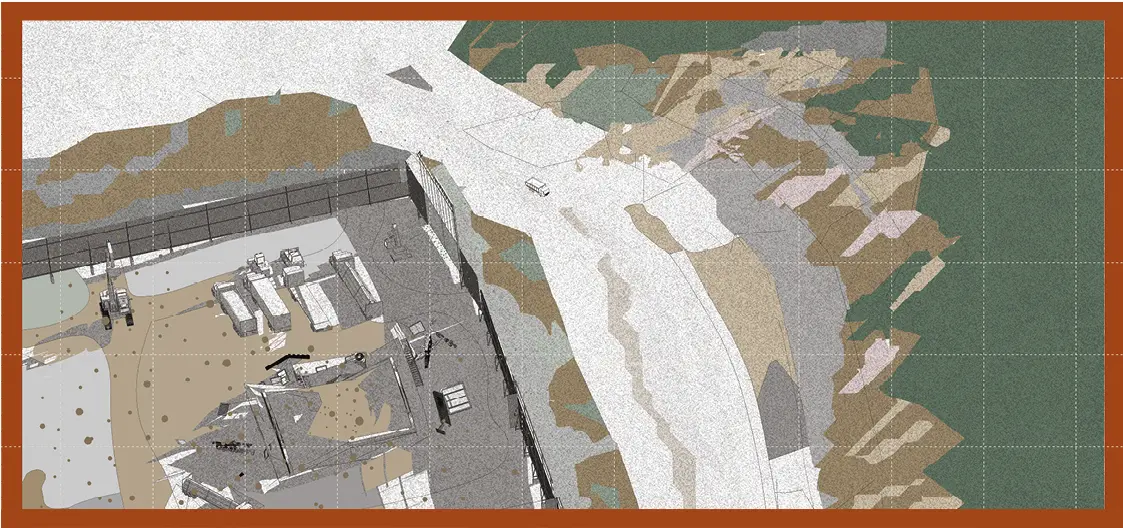
Dirty & Green
BY Lee Zhi Ning
SUPERVISED BY Senior Visiting Fellow, Victoria Jane Marshall (Dr.)
STUDIO THEME HUMANS, NONHUMANS, AND NONHUMAN AGENCIES
Abstract
Introduction
Soil is generally thought to be firm and stable, yet geologically, it proves to be otherwise. It is subjected to localised pressures on the thinnest layers of our fertile soils to deep pressure from the earth’s core. These pressures are documented in a geological history that appears to have excluded humans, until recently. Scientists and historians have gathered new evidence, revealing the extent of human influence on soil as it has become visible not just horizontally, but also vertically by the accumulation of things like plastic and concrete, and actions that have penetrated the soil to its deepest strata, disturbing and mixing strata of eras that would otherwise never have met. The soil is never left to rest. (Aït-Touati et al., n.d.) This project locates architecture in a micro way, and asks, what does the rhizosphere say to architecture, instead of the current reverse.
Abstract
Dirty and Green situates itself in Singapore and examines the past three urban policies that look at nature and the city. The recent shift from ‘garden’ to ‘nature’ is a policy change that accommodates ‘wild’ nature. The project argues that, the binary of city and nature is a good start in attempting to rewild the city, but it is not enough because the notion of ‘wild’ is not defined and it is evolving at present. In order to be precise, specificity about ‘what nature’ is required, and the selection of what to be specific about is political. The thesis argues that a policy of vaguely imagined ‘wildness’ is a barrier to actually addressing what a public, ecological city could be. The thesis argues within the current, ‘City in Nature' urban policy and in Singapore's constant state of becoming. I have imagined a dirty political agent that can expand the poorly defined ‘wild nature' and can shape urban spatial change in novel and necessary ways. My design action takes place in the rhizosphere, which is the importantly productive, thin layer around the earth where water, soil, subsoil, and the living world interact, and where human and nonhuman life and the resources that sustain it are concentrated. Can a ‘dirty’ confrontation with ‘City in Nature' inspire and open up future urban-nature imaginaries in new ways? The project hopes to encourage the proposal of similarly missing or forgotten dirty, ‘wild natures' for architecture-based research in Singapore.
Research processes
1. Mapping evidence of entanglement (Hodder, 2012) between rhizospheres and concrete in Singapore, shows that there is a problematic and counterproductive entanglement engendered by generic and utopic ‘fixes' for public space.
2. Project sites are selected based on a geologically loose logic selection in western Singapore based on soil. I select four sites and I situate myself in relation to them following a relational positionality (Kobayashi, 2019). Where I ‘see with' each site and bring various expositions to the specific soil site, rather than position myself as an outsider to nature and the city. Each of the four sites are represented through soil pigments that I collect from each site, converted to paint and applied on a series of not-to-scale, sectional diptychs.
3. Rejecting broad generalisations of standard, typical details, like sidewalks and scaffolding, which do not take account of the rhizosphere. In response, I undertake an analysis of soil through its bearing capacity diagrams, and propose for public rhizosphere spaces to look beyond design and maintenance for resilience.
4. Designing with the rhizosphere as a built condition that can be rebuilt on each site, such that there is a recursive relationship between the designed and undesigned.
5. Developing a local code that progresses from a holistic, circular framework type of policy to a protocol that is non-deterministic and linear. This requires the alignment of people and things, in ways that are responsive to uncertainties, materialities, and passions. It is one that activates the soil, and results in discernable change. This involves the collaboration with local soil collectives to mobilise and implement this protocol.
Supervisor Comments
The project Dirty and Green imagines a scenario for the creation and management of the rhizosphere across Singapore. The thesis asks, how can ‘dirt’ practices be inserted into redevelopment processes, and in turn, inform future land use? Based on a close study of existing policy and its over-emphasis on bearing capacity, the project introduces a set of tactics that show processes of soil formation and deformation. The project also proposes novel collectives that grip onto the continued enrichment of the rhizosphere. By retrofitting existing machines, tools, and edges, Zhining has designed a remarkable micro-architecture for an understudied topic, urban soil.
- Senior Visiting Fellow, Victoria Jane Marshall (Dr.)